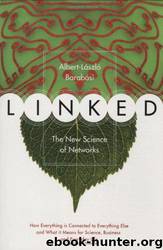Linked: The New Science of Networks by Albert-László Barabási

Author:Albert-László Barabási
Language: pt
Format: mobi
Tags: World Wide Web, Economics, Networking, Social Science, Computer networks, Computers, General, Mathematical Physics, Social networks, Science, Miscellanea, Philosophy, System Theory, Business & Economics
ISBN: 9780738206677
Publisher: Perseus Pub.
Published: 2002-03-15T03:00:00+00:00
two nodes in a directed network, you can connect them through other nodes: For example, if you want to go from A to D, you can start from node A, then go to node B, which has a link to node C, which points to D. But you can't make a round-trip. In a nondirected network, where you can follow a link in both directions, anA->B->C->D path implies that the shortest path from D to A is the reverse one, D C B —> A. In a directed network, however, there is no guarantee that the in-
verse path exists. Most likely you would have to follow a different route back: From D you might need to visit dozens of intermediate nodes before getting back to A. The Web is full of such disjointed directed paths. They fundamentally determine the Web's navigability.
Directed networks do not represent a fundamentally new class of networks: Whether the network is scale-free or random, the links can be either directed or nondirected. So far we have dealt with mostly nondirected links. Indeed, most webs, ranging from social to protein interaction networks, are nondirected. But some networks, ranging from the World Wide Web to food webs, have directed links. This directed-ness has consequences for the network's topology. In the context of the World Wide Web these consequences were first addressed by Andrei Broder, from AltaVista, and his collaborators from IBM and Compaq. They studied a sample of 200 million nodes, close to a fifth of all Webpages in existence in 1999. Their measurements indicated that the most important consequence of directedness is that the Web does not form a single homogeneous network. Rather, it is broken into four major continents (see Figure 12.1), each forcing us to obey different traffic rules when we want to navigate them.
The first of these continents contains about a quarter of all Webpages. Often called the central core, it gives a home to all major Websites from Yahoo! to CNN.com. Its distinguishing feature is that it is easily navigable, since there is a path between any two documents belonging to it. This does not mean that there is a direct link between any two nodes of the central core. Rather, there is a path along nodes belonging to the core that allows you to surf between any two nodes.
The second and third continents, called IN and OUT, are just as large as the central core but much harder to navigate. From the pages of the IN continent you can reach the central core, but there are no paths from the core taking you back to IN land. In contrast, the nodes belonging to the OUT continent can be easily reached from the central core, but once you have left the core, there are no links to take you back. The OUT land is populated by corporate Websites that can be easily reached from outside; but once you get in, there is no way out. The fourth continent is made of tendrils and
Download
This site does not store any files on its server. We only index and link to content provided by other sites. Please contact the content providers to delete copyright contents if any and email us, we'll remove relevant links or contents immediately.
| Anthropology | Archaeology |
| Philosophy | Politics & Government |
| Social Sciences | Sociology |
| Women's Studies |
Cecilia; Or, Memoirs of an Heiress — Volume 1 by Fanny Burney(32434)
Cecilia; Or, Memoirs of an Heiress — Volume 2 by Fanny Burney(31871)
Cecilia; Or, Memoirs of an Heiress — Volume 3 by Fanny Burney(31852)
The Great Music City by Andrea Baker(31348)
We're Going to Need More Wine by Gabrielle Union(18967)
All the Missing Girls by Megan Miranda(15565)
Pimp by Iceberg Slim(14393)
Bombshells: Glamour Girls of a Lifetime by Sullivan Steve(13972)
Talking to Strangers by Malcolm Gladwell(13222)
Norse Mythology by Gaiman Neil(13204)
Fifty Shades Freed by E L James(13157)
For the Love of Europe by Rick Steves(12977)
Mindhunter: Inside the FBI's Elite Serial Crime Unit by John E. Douglas & Mark Olshaker(9200)
Crazy Rich Asians by Kevin Kwan(9167)
The Lost Art of Listening by Michael P. Nichols(7406)
Enlightenment Now: The Case for Reason, Science, Humanism, and Progress by Steven Pinker(7228)
The Four Agreements by Don Miguel Ruiz(6630)
Bad Blood by John Carreyrou(6552)
Weapons of Math Destruction by Cathy O'Neil(6143)
